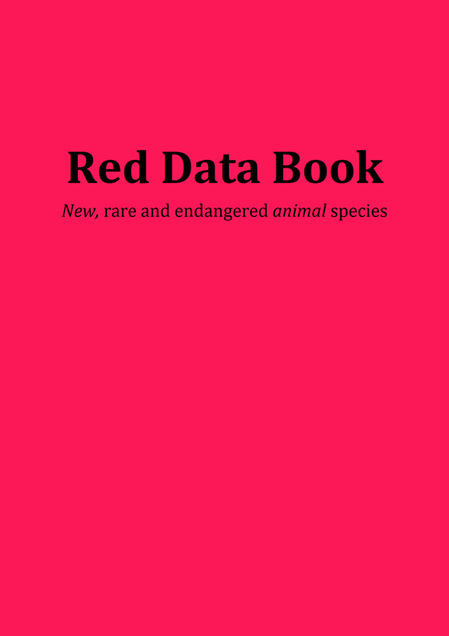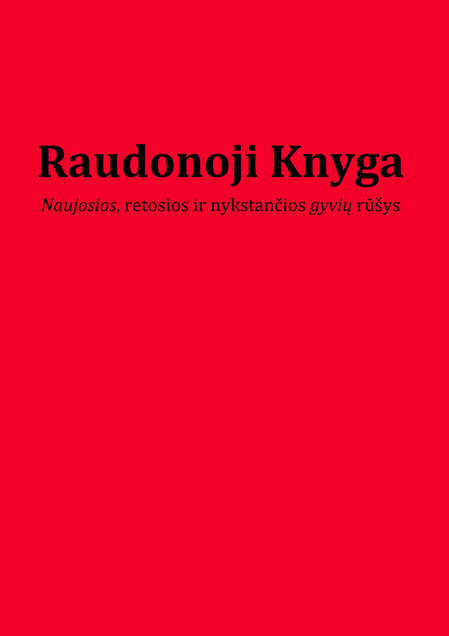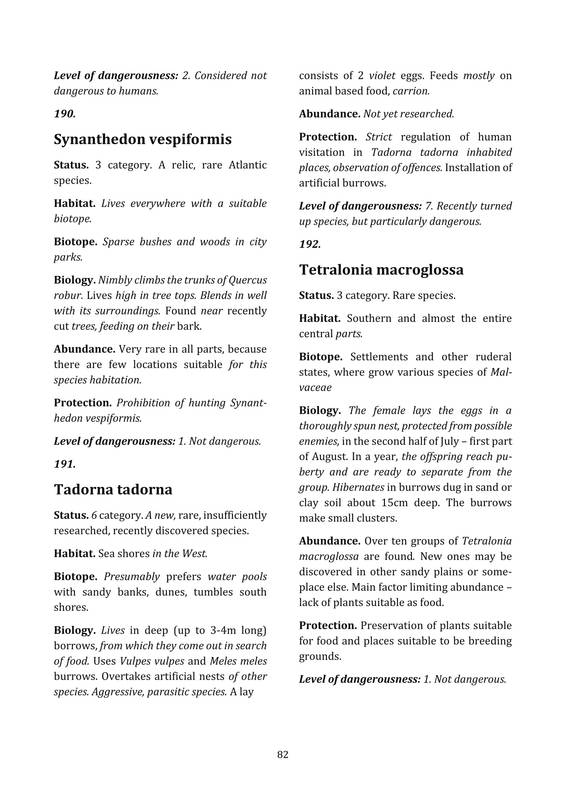Red data book : new, rare and endangered animal species
While searching for reality reflections through creativity, you start disbelieving your own eyes and existing notions.The Red data book : new, rare and endangered animal species is a portion of my, as a creator, implemented art project n e w k i n d. At the beginning, everything revolved around new (none)existing animal species, the creation of its narratives and biological description encouraged the search of a specific scientific system in which I would be able to insert the animal and establish its existence more fully. The characteristics of the species, its timidity, obscurity and the presence in a certain periphery led me to remember and re-discover the Lithuanian Red Data Book. The medium of the publication about rare and endangered species of animals, plants and fungus, perfectly suited for alterations and the accommodation of a new animal species. The Lithuanian Red Data book itself, representative of the discourse of the biology science, unquestioned truth, particular system of knowing and cognition of the nature is varying in the process of appropriation and is displaying in different thematic aspects.
The fate of endangered species became the concern in the world in the second half of 20th century. Special lists were compiled, their purpose - present corpus of knowledge and solutions to help organize the protection and restoration of endangered species. The processes in Lithuania started slightly later. The first, thinnest, with the least amount of described species, The Lithuanian Red Data Book (at the time – Lithuanian SSR Red Data Book) was published in 1981. Later followed by the 1992 and 2007 editions, with gradually extending volume and lists.
I chose to work with the second publication (Red Data Book of Lithuania: rare, and endangered species of animals, plants and fungi, formed by K. Balevičius, Vilnius : Lithuanian Environment Protection Department, 1992), hereinafter will be called original, and my rewritten and appropriated version – The Red Data Book.
The text of the Red Data Book is compiled according to these rules:
In the original version, presented are descriptions of animals, plants and fungi, however in The Red Data Book only the animals are appropriated. This was decided for the purpose of more narrow theme and to mark the aspects of human and non-human animal relations. There are 210 rewritten
species altogether, the exact same amount as the sum of all the animals in the original. 1 entry is changed entirely, from its title to the characteristics of the living being (the new species, (n e w k i n d) Timidos cognoscitur, number 196). The descriptions of the animals consist of: mammals, birds, reptiles, amphibians, fish, molluscs, insects, crustaceans, leeches.
The text of the original Lithuanian Red Data book was altered and some elements were deleted, however without displacing them. For example, if some words are removed from the sentence, altered words are inserted in their place, or if nothing is inserted, the sentence becomes shorter changing its sense as the remaining words generate new meanings.
The parlance in the preface of the original as well as the rewritten version is kept a bit pageantry, with pride, as if this publication would be a huge favour for the nature and the society. There are repeating words in the preface: protect, take action, proliferate, control – all speaking about intervention and application of own rules in the nature.
In the Red Data Book all the living beings are listed in Latin alphabetical order, all descriptions have unified scheme. The alterations in each of the segments where executed as follows:
Title. Familiar names of the animals were eliminated, only the scientific Latin titles were kept. This limits the number of people understanding what species are communicated. The creature becomes unrecognisable to none-biologist or the specialist of the area. Its name sounds like a jumble of words. There is no semblance to the appearance of the animal in its name, the word no longer relates to a specific object. The “real” image of the animal is eliminated and is re-forming in the biological description and in the interpretation of the reader. The recycled scientific system takes on the features of a myth. The animal becomes mystified. The existing, real species becomes cryptic in appropriation, fictitious living being. Names of the animals in descriptions are most often changed into the word creature. It is probably the most aggressive and furthermost abstract sounding des-cription in which it would be possible to logically define both a bird and an insect. If the description doesn’t define precisely, their sizes and other specifics become unclear. Suddenly, in the imagination of the reader, a rare butterfly might turn into dangerous flying creature etc.
Status. The creature is assigned to a specific category, that are described in more detail in the original. Here alterations are marginal, only the living beings that are suitable with their properties, where changed into new, added in italic, 6th category (New, rare, little researched species). This category stands out with the descriptions of its creatures being rather short due to the lack of data. Therefore, when the species with significantly concise descriptions, minimum information and the indication of lack of data where noticed in the original, they were changed into 6th category added by me. Later their descriptions were modified keeping this in mind.
Prevalence. All the names of a specific locations were repealed; proper nouns were refused avoiding political aspect and the attachment to location. In most cases the description of a location is replaced with the word territory, with indication of direction at times, for instance – the northern part of the territory etc. The territory becomes a vague locality in time and space, for if it would be stated, that let’s say the animal is abundant is the eastern part of Soviet Union, the overly obvious links to a specific period in time and historical matters would appear. Territory – as a periphery, where all of those little known for us, new and endangered species exist.
Biotope. This chapter was left almost the least rewritten, many des-criptions of the biotopes remain the same as in the original version. All the mentioned specific names of the plants or the animals in the description are changed into Latin.
Biology descriptions were changed the most and received most attention after which other chapters were then adjusted. Biology chapter conveys the most about the image, how the animal could look like, what are its properties etc. When the incoherence of the original version was noticed, the same method was applied to the Red Data Book. In both the original and the rewritten version descriptions are very different. Some animals have descriptions with plenty of information, how they reproduce, how they install their habitats, how they take care of their offspring, while the others have only few sentences mentioning their appearance properties. Rewriting was conducted following and interpreting the given plot while ensuing the same manner of writing.
Abundance. Was adjusted keeping in mind the biological descriptions of the animals and the information provided in the original. Again, eliminating all proper nouns as well as specific locations of sightings, occasionally introducing the factor limiting abundance by human intervention, for example hunting of the species for their fur. Chapter “Abundance” is also the evidence of the human will of empirical classification and the calculation and in this case, to keep the track of. In many descriptions of the original version, there were mentions of specific locations, names of localities as well as the population numbers in them, however as all of the proper nouns were abandoned during the rewriting process, the informativeness of the chapter slightly transformed.
Protection. This chapter is executed while keeping in mind Biology and Abundance descriptions, the solutions for protection from the original version are often used. The main purpose of the original Red Data Book is to protect the species from extinction while implementing specific plans of protection. Thus, the essence – intervention into the nature, its transfiguration, accommodation to human needs. And although the extinction as well as the turnover of the species is considered a natural process, the changing of those processes while applying man made scenario seems more natural practice. Various solutions for the supervision of the species are given in the chapter “Protection” in both the original version as well as in the Red Data Book. It varies from the installation of artificial nests to the breeding in the zoos or the quantity regulation of other, non-endangered predatory animals (I. e. diminution). This chapter mostly addresses and displays that feeling of control the humanity is obsessed with.
Dangerousness. There was no such chapter in the original version, it was indrawn in pursuit of intensity. The level of dangerousness indicated while keeping in mind the biological properties of the living being. Chapter reveals the human fear of being attacked and occupied by other species, furthermore the portrayal of the living being is finished with either its timidity or, on the contrary – outbreaks of aggression.
-
The italic font used in the text of the Red Data Book is the writing inserted or changed by me, whereas the original information is kept in regular lettering.
For example:
“For a long time, the ways to stop or at least predict and manage, the extinction of the plants and the animals, are being searched in the world.”
Everything is written in normal font, whereas the reader can trust the information.
Different version of the same sentence:
“For a long time, the ways to stop or at least predict and manage, the extinction of the plants and the animals, are being searched in the world.”
The italic font appears, it can be suspected as misleading, its given information can be questioned, although it is visible from the original sentence above, nothing has changed in the second version. The O r i g i n a l is being mistrusted.
Other examples:
- The animal is not dangerous.
- The animal is not dangerous.
- The animal is not dangerous.
The text written in italic makes you speculate and interpret what was written in the original before it was changed. Italic font becomes the indicator of a mistake, intervention, falsification, whereas regular font – correct scientific discourse. Though even if the text itself is not altered but the reader is unaware of this, the game with fonts provokes the questioning of the formed scientific reality. The new notion is born in the interpretation.
Normal font – truth, italic – fiction.
-
The search of reality torments many artists, however everybody chooses their own way. I try to grasp certainty through the nature, and we only get to know her while classifying and describing. The science of Biology becomes the medium that sets us closer to the understanding of nature’s phenomenon. The Red Data Book – is a system. Created with the use of “devisualised” biological information and inserting the moment of mistake while following its narrative. The preface added to the material version of the Book, reveals the rules of the “game”. If removed, the Red Data Book becomes autonomous fictional scientific system. Through the animals and the surface of the biology science, the Red Data Book communicates about human, his lines of perception and the wish to direct all that is around him. The Red Data Book – it is incertitude about certainty. Both of visual and scientific. It is the search for reality.
I n d r ė
-
-
-
www.reddatabook.com is an interactive website created on the basis of Red Data Book: New, Rare and Endangered Animal Species. Everyone can join in and contribute their own sounds. Click register or login and start interpreting fictional animals through the medium of sound. Follow the written rules, create and record the sounds made by the described animal or adapt already-existing sounds. After uploading your own sound, you will be able to listen to other users’ creations. Become a non-human animal yourself. There are no profession, age or species limits.
Fragments of Red Data Book: New, Rare and Endangered Animal Species:
At the exhibitions:
At Jonas Mekas Visual Arts Center, Vilnius, Lithuania
At Akademija gallery, Vilnius, Lithuania
Sound installation based on www.reddatabook.com, site-specific art festival Narracje, Gdansk, Poland. Photo by Bogna Kociumbas
Sound installation based on www.reddatabook.com, organized with Rezydencja Fundacja Artystów Kolonia Teraz, in Biology University of Gdansk, Poland. Photo by Mikołaj Robert Jurkowski













